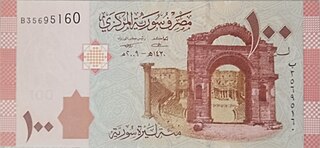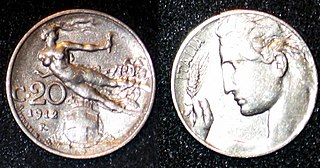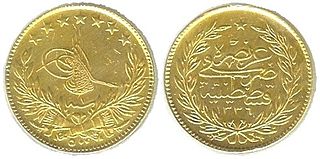
Pound is the name of various units of currency. It is used in some countries today and previously was used in many others. The English word "pound" derives from the Latin expression lībra pondō, in which lībra is a noun meaning 'pound' and pondō is an adverb meaning 'by weight'. The currency's symbol is '£', a stylised form of the blackletter 'L', crossed to indicate abbreviation.

The Latin Church of the Catholic Church has several dispersed populations of members in the Middle East, notably in Turkey, Cyprus and the Levant. Latin Catholics employ the Latin liturgical rites, in contrast to Eastern Catholics who fall under their respective church's patriarchs and employ distinct Eastern Catholic liturgies, while being in full communion with the worldwide Catholic Church. Latin Catholics in the Middle East are often of European descent, particularly from the medieval Crusader era and later the 20th-century colonial period.

The pound sign is the symbol for the pound unit of sterling – the currency of the United Kingdom and its associated Crown Dependencies and British Overseas Territories and previously of Great Britain and of the Kingdom of England. The same symbol is used for other currencies called pound, such as the Egyptian and Syrian pounds. The sign may be drawn with one or two bars depending on personal preference, but the Bank of England has used the one-bar style exclusively on banknotes since 1975.

The Syrian pound or lira is the currency of Syria. It is issued by the Central Bank of Syria. The pound is nominally divided into 100 piastres, although piastre coins are no longer issued. All banknotes and coins below 50 pounds are practically worthless by Dec 2022.

Kuruş, also gurush, ersh, gersh, grush, grosha, and grosi, are all names for currency denominations in and around the territories formerly part of the Ottoman Empire. The variation in the name stems from the different languages it is used in and the different transcriptions into the Latin alphabet. In European languages, the kuruş was known as the piastre.

The piastre or piaster is any of a number of units of currency. The term originates from the Italian for "thin metal plate". The name was applied to Spanish and Hispanic American pieces of eight, or pesos, by Venetian traders in the Levant in the 16th century.

The lira or pound was the currency of Malta from 1972 until 31 December 2007. One lira was divided into 100 cents, each of 10 mils. After 1986 the lira was abbreviated as Lm, although the original £M sign continued to be used unofficially. In English the currency was still frequently called the pound even after its official English language name was changed to lira.

The pound, or lira, was the currency of Cyprus, including the Sovereign Base Areas in Akrotiri and Dhekelia, from 1879 to 2007, when the Republic of Cyprus adopted the euro. However, the self-proclaimed Turkish Republic of Northern Cyprus uses the Turkish lira as its official currency.

The lira was the currency of Italy between 1861 and 2002. It was introduced by the Napoleonic Kingdom of Italy in 1807 at par with the French franc, and was subsequently adopted by the different states that would eventually form the Kingdom of Italy in 1861. It was subdivided into 100 centesimi, which means "hundredths" or "cents". The lira was also the currency of the Albanian Kingdom from 1941 to 1943.
Lira is the unit of currency of various countries.

The lira is the official currency of Turkey and Northern Cyprus, as well as one of the two currencies used in northern Syria under the country's interim government. One lira is divided into one hundred kuruş.

Centesimo is a currency unit equivalent to cent, derived from the Latin centesimus meaning "hundredth". In Italy it was the 1⁄100 division of the Italian lira.
L, or l, is the twelfth letter of the Latin alphabet, used in the modern English alphabet, the alphabets of other western European languages and others worldwide. Its name in English is el, plural els.

The pound or lira is the currency of Lebanon. It was formerly divided into 100 piastres but, because of high inflation during the Lebanese Civil War (1975–1990), subunits were discontinued.

The international status and usage of the euro has grown since its launch in 1999. When the euro formally replaced 12 currencies on 1 January 2002, it inherited their use in territories such as Montenegro and replaced minor currencies tied to pre-euro currencies, such as in Monaco. Four small states have been given a formal right to use the euro, and to mint their own coins, but all other usage outside the eurozone has been unofficial. With or without an agreement, these countries, unlike those in the eurozone, do not participate in the European Central Bank or the Eurogroup.
In computing HP Roman is a family of character sets consisting of HP Roman Extension, HP Roman-8, HP Roman-9 and several variants. Originally introduced by Hewlett-Packard around 1978, revisions and adaptations were published several times up to 1999. The 1985 revisions were later standardized as IBM codepages 1050 and 1051. Supporting many European languages, the character sets were used by various HP workstations, terminals, calculators as well as many printers, also from third-parties.

Italy has a long history of different coinage types, which spans thousands of years. Italy has been influential at a coinage point of view: the medieval Florentine florin, one of the most used coinage types in European history and one of the most important coins in Western history, was struck in Florence in the 13th century, while the Venetian sequin, minted from 1284 to 1797, was the most prestigious gold coin in circulation in the commercial centers of the Mediterranean Sea.

The pound or lira was the currency of the Ottoman Empire from 1844 until 1927, when it was replaced by the Turkish lira. The Ottoman lira remained in circulation until the end of 1927, as the republic was not in a position to issue its own banknotes yet in its early years.


















